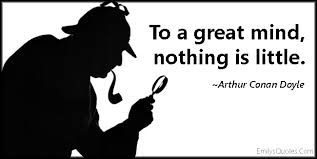The Game is Afoot… CELEBRATING Sir Arthur Conan Doyle, HAPPY BIRTHDAY
You probably know Sir Arthur Conan Doyle as the creator of the world’s most famous detective, Sherlock Holmes. But as significant as Sherlock Holmes is, it’s only a small part of the author’s story. In addition to his mysteries, Arthur Conan Doyle was a prolific writer who wrote fantasy, science fiction, plays, romance, poetry, non-fiction, humor, and historical fiction.
……but did you know……
……Conan Doyle was also an enthusiastic investigator. He amateurishly solved a couple of mysteries.
A particular one which gained much popularity was when he successfully got the Oscar Slater released from prison. Oscar Slater was wrongly convicted of the murder of an 82-year-old woman.
……..Doyle killed his most famous creation Sherlock Holmes, the same year his alcoholic father died in an asylum – 1893.
It is also said and believed that he killed Sherlock so that he could focus on writing about his passion – Spiritualism.
………The celebrated detective returned, however. Doyle had to resurrect him ten years later, on public demand and monetary grounds.
Doyle believed that the money earned through Sherlock books could be used to for popularizing spiritualism.
……… Doyle believed in fairies.
………. Doyle’s first book was lost in the post. At the age of 23, he wrote his first book and had it sent in the mail to a publisher.
But the post was lost and he actually rewrote the book up to 150 pages before finally deciding to give up.
The mail and book remain a mystery to this date.
You probably do know that he was most noted for creating the fictional detective Sherlock Holmes and writing stories about him which are generally considered milestones in the field of crime fiction.
Despite Arthur Conan Doyle’s ambivalent feelings about his most famous character, Sherlock Holmes remains the largest part of the author’s legacy. Holmes has had a huge impact on the world in ways the author was likely unable to imagine. In addition to shaping detective fiction as we know, Sherlock Holmes has also had an amazing impact on real-life criminal investigation and forensic techniques. Arthur Conan Doyle was able to accomplish a lot in his lifetime, but it’s Sherlock Holmes who will live on forever.
Sherlock Holmes
Holmes was partially modeled on his former university teacher Joseph Bell. In 1892, in a letter to Bell, Doyle wrote,
"It is most certainly to you that I owe Sherlock Holmes ... round the center of deduction and inference and observation which I have heard you inculcate I have tried to build up a man."and, in his 1924 autobiography, he remarked,
"It is no wonder that after the study of such a character [viz., Bell] I used and amplified his methods when in later life I tried to build up a scientific detective who solved cases on his own merits and not through the folly of the criminal.Robert Louis Stevenson was able, even in faraway Samoa, to recognize the strong similarity between Joseph Bell and Sherlock Holmes:
"My compliments on your very ingenious and very interesting adventures of Sherlock Holmes. ... can this be my old friend Joe Bell?"Doyle's attitude towards his most famous creation was ambivalent. In November 1891 he wrote to his mother: "I think of slaying Holmes,... and winding him up for good and all. He takes my mind from better things." His mother responded, "You won't! You can't! You mustn't!"
In an attempt to deflect publishers' demands for more Holmes stories, he raised his price to a level intended to discourage them, but found they were willing to pay even the large sums he asked. As a result, he became one of the best-paid authors of his time.
In 1903, Doyle published his first Holmes short story in ten years, The Adventure of the Empty House, in which it was explained that only Moriarty had fallen; but since Holmes had other dangerous enemies—especially Colonel Sebastian Moran—he had arranged to also be perceived as dead. Holmes was ultimately featured in a total of 56 short stories—the last published in 1927—and four novels by Doyle, and has since appeared in many novels and stories by other authors.
Doyle's stage works include Waterloo, the reminiscences of an English veteran of the Napoleonic Wars, the character of Gregory Brewster being written for Henry Irving; The House of Temperley, the plot of which reflects his abiding interest of boxing; The Speckled Band, after the short story of that name; and the 1893 collaboration with J.M. Barrie on the libretto of Jane Annie.
Doyle had a longstanding interest in mystical subjects. In 1887 he joined the Society for Psychical Research.
Although Houdini insisted that Spiritualist mediums employed trickery (and consistently exposed them as frauds), Doyle became convinced that Houdini himself possessed supernatural powers—a view expressed in Doyle's The Edge of the Unknown. Houdini was apparently unable to convince Doyle that his feats were simply illusions, leading to a bitter public falling out between the two.
“Building Great Collections One Fine Book at a Time”
Check us out at www.BlindHorseBooks.com











Comments
Post a Comment